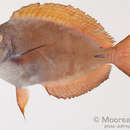Diagnostic Description
provided by Fishbase
Brown in color when preserved; with or without fine bluish gray longitudinal lines on body; pale pectoral fins with upper edge narrowly black; pelvic fins brown. Lips blackish brown; median upper teeth tend to be pointed. Dorsal fin base with a prominent black spot larger than 1/2 eye diameter; a smaller spot on base of anal fin. Groove of caudal spine encircled with a narrow black margin. Gill rakers on anterior row:20-24; on posterior row:18-23.Description: Characterized further by having a caudal spine length about 3.0 in head length; greatest depth of body 2.0-2.3 in SL (Ref. 90102).
- Recorder
- Estelita Emily Capuli
Life Cycle
provided by Fishbase
Form spawning aggregations (Ref. 27825).
Morphology
provided by Fishbase
Dorsal spines (total): 9; Dorsal soft rays (total): 24 - 27; Analspines: 3; Analsoft rays: 22 - 24
- Recorder
- Estelita Emily Capuli
Trophic Strategy
provided by Fishbase
Found on hard substrates of shallow lagoon and seaward reefs from the lower surge zone to a depth of more than 15 m. Herbivorous, feeds on filamentous Ref. 43650) and turf algae (Ref. 59111). Form spawning aggregations (Ref. 27825, 48637). Adults usually in small groups, but form large schools in some oceanic locations. Juveniles are often seen in mixed species aggregations (Ref. 48637). A species at the bottom of the 'pecking order' among surgeon fishes, and as a result employs the strategy of feeding in large schools that overwhelm the territorial defenses of other herbivores (Ref. 1602). During feeding, each bite is characterized by a quick nip at algal filaments, usually followed by a sidewards flick of the head. The jaws bear several broad multidenticulate teeth which appear engage turf algal strands either sheared during mouth closure or torn off as the head flicks sideways (Ref. 59059).
- Recorder
- Estelita Emily Capuli
Biology
provided by Fishbase
Found on hard substrates of shallow lagoon and seaward reefs from the lower surge zone to a depth of more than 15 m (Ref. 27825). Benthopelagic (Ref. 58302). Feed on filamentous algae. Form spawning aggregations (Ref. 27825, 48637). Adults usually in small groups, but form large schools in some oceanic locations. Juveniles are often seen in mixed species aggregations (Ref. 48637). Species at the bottom of the 'pecking order' among surgeon fishes, and as a result employs the strategy of feeding in large schools that overwhelm the territorial defenses of other herbivores (Ref. 1602). Caught with nets (Ref. 30573). Can be eaten both raw and cooked (Ref. 7364). Maximum depth reported at 25m (Ref. 027115)
- Recorder
- Estelita Emily Capuli
Importance
provided by Fishbase
fisheries: commercial; aquarium: commercial
- Recorder
- Estelita Emily Capuli
分布
provided by The Fish Database of Taiwan
廣泛分布於印度-太平洋區,西起紅海、非洲東部,東至馬貴斯及土木土群島,北至日本,南至澳洲大堡礁及新加勒多尼亞。台灣各地海域及離島均曾發現,以北部、東北部海域最多。
利用
provided by The Fish Database of Taiwan
一般以流刺網、延繩釣或潛水鏢魚法等捕獲。觀賞及食用兼具。剝皮後,煮薑絲湯,肉質鮮美。尾柄上骨質盾板非常銳利,易傷人,處理時需小心。因食物鰱之關係,可能具熱帶海魚毒。
描述
provided by The Fish Database of Taiwan
體呈橢圓形而側扁。頭小,頭背部輪廓隨著成長而凸出。口小,端位,上下頜各具一列扁平齒,齒固定不可動,齒緣具缺刻。背鰭及臀鰭硬棘尖銳,分別具XI棘及III棘,各鰭條皆不延長;胸鰭近三角形;尾鰭彎月形,隨著成長,上下葉逐漸延長。體一致為紫褐色至褐色,體側具不顯著之藍灰色線紋,有時消失;頭及胸部散佈橘色小點;唇黑褐色。背鰭及臀鰭黃褐色至紫褐色,鰭緣為淡藍色,基底末緣各具1個黑色斑駁,背鰭末緣之黑色斑駁較大;尾鰭一致紫褐色至黑褐色,末端鰭緣為白色;胸鰭及腹鰭淡褐色;尾柄棘溝緣為黑褐色。
棲地
provided by The Fish Database of Taiwan
主要棲息於潟湖淺灘及面海礁石的堅硬底部,一般的棲息深度由浪拂區至15公尺左右,最深可達25公尺,是淺水域礁區常見的魚種。成魚平時不太聚集成群,僅有在產卵時期才會聚集成群之習性,但是在一些大洋性的島嶼區域則有聚集成大群的現象。幼魚有混居在其他魚種群集的現象。某些區域可以發現在覓食時也會有聚集成群以抵抗其它具有領域性的草食魚類攻擊的現象。以絲狀藻類為食。
Acanthurus nigrofuscus
provided by wikipedia EN
Acanthurus nigrofuscus, also known as the lavender tang, brown tang, or spot-cheeked surgeonfish, is a tang from the Indo-Pacific and Hawaii. It commonly makes its way into the aquarium trade. It grows to 21 cm in length.[2] Recently, a huge bacterium discovered in its intestine, Epulopiscium fishelsoni,[3][4] has been found to grow as large as 600 by 80 μm, a little smaller than a printed hyphen, which controls the pH of its host's gut, thereby influencing its host's ability to digest food and absorb nutrients.
Diet
The lavender tang is an herbivore that grazes primarily on benthic algae. In captivity, they will also feed on animal matter such as brine shrimp and mysis shrimp.
References
-
^ Choat, J.H.; McIlwain, J.; Abesamis, R.; Clements, K.D.; Myers, R.; Nanola, C.; Rocha, L.A.; Russell, B.; Stockwell, B. (2012). "Acanthurus nigrofuscus". IUCN Red List of Threatened Species. 2012: e.T178019A1523035. doi:10.2305/IUCN.UK.2012.RLTS.T178019A1523035.en. Retrieved 20 November 2021.
-
^ "Acanthurus nigrofuscus, Brown surgeonfish : Fisheries, aquarium". Archived from the original on February 28, 2014. Retrieved May 13, 2015.
-
^ Angert ER, Clements KD, Pace NR (1993). "The largest bacterium". Nature. 362 (6417): 239–241. doi:10.1038/362239a0. PMID 8459849.
-
^ Angert ER, Brooks AE, Pace NR (1996). "Phylogenetic analysis of Metabacterium polyspora: Clues to the evolutionary origin of Epulopiscium spp., the largest bacteria". Journal of Bacteriology. 178 (5): 1451–6. PMC 177821. PMID 8631724.

- license
- cc-by-sa-3.0
- copyright
- Wikipedia authors and editors
Acanthurus nigrofuscus: Brief Summary
provided by wikipedia EN
Acanthurus nigrofuscus, also known as the lavender tang, brown tang, or spot-cheeked surgeonfish, is a tang from the Indo-Pacific and Hawaii. It commonly makes its way into the aquarium trade. It grows to 21 cm in length. Recently, a huge bacterium discovered in its intestine, Epulopiscium fishelsoni, has been found to grow as large as 600 by 80 μm, a little smaller than a printed hyphen, which controls the pH of its host's gut, thereby influencing its host's ability to digest food and absorb nutrients.
- license
- cc-by-sa-3.0
- copyright
- Wikipedia authors and editors
Description
provided by World Register of Marine Species
Found on hard substrates of shallow lagoon and seaward reefs from the lower surge zone to a depth of more than 15 m. Feeds on filamentous algae. A species at the bottom of the 'pecking order' among surgeonfishes, and as a result employs the strategy of feeding in large schools that overwhelm the territorial defenses of other herbivores (Ref. 1602). Can be eaten both raw and cooked (Ref. 7364).
Froese, R. & D. Pauly (Editors). (2023). FishBase. World Wide Web electronic publication. version (02/2023).
- license
- cc-by-4.0
- copyright
- WoRMS Editorial Board

